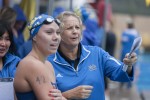Once a week, Spieker Aquatics Center becomes a strange sight for those not entirely familiar with the UCLA swim team.
Instead of merely repeating lap after lap in the same way, the UCLA swim team members can be seen swimming furiously toward one end of the pool where teammates are pulling them back as aggressively with athletic elastic bands.
Some girls pull parachutes behind them in the next pool over as they swim from one end of the lane to the next. One of the drills that the team often does includes hoisting buckets of water up a pulley with the force of their own swimming, by strapping a band connected to one end of a thick cord to their waists and swimming away from a rack to which the buckets are fastened. As they swim to the far end of the lane, the buckets rise. As they return, so do the buckets.
These weighted exercises ensure that once the swimmers are freed from the various training equipment, they swim faster than they normally would.
Senior swimmer Taylor Carlson said these drills aim to create “higher tempo” in the swimmers’ efforts.
“You’re able to move your arms through the water faster … because you’re not focused on pulling a lot of water, but focused on getting your arms over faster,” Carlson said.
This is especially true in the assisted bands portion of the circuit, which Carlson says is her favorite. It’s meant to simulate how someone would ideally want to swim in a race – much faster, and with a much higher turnover rate.
The Bruins have also in the past utilized specialized goggles that show a particular stroke to the viewer over and over again. The swimmer watches the stroke for two or three minutes and then puts on different, blackout goggles, which essentially make her blind in the pool. She then tries to swim and replicate the stroke that she watched. This drill is much more of a mental exercise than the aforementioned, as is one of coach Cyndi Gallagher’s personal favorites: backward swimming.
Backward swimming is not simply a backstroke, but literally executing any given stroke entirely backward. Gallagher said that forcing the team members to swim in this way makes them think about and become entirely familiar with each step of their stroke. It seems to have been working, considering their success in Friday’s dual meet against Oregon State.
“We did (backward swimming) relay with Oregon State, and we crushed them,” Gallagher said.
In addition to workouts in the pool, UCLA swim also cross-trains regularly.
The swimmers run and lift weights throughout the year, but Gallagher likes to “add variety so they don’t get bored.” She had the team take up boxing last quarter, and yoga and pilates this quarter.
“Sometimes … you don’t know how to activate (a) muscle. (In cross-training) we got to know what each muscle did and how it connected with our rotation. Now we can use that knowledge when we’re swimming,” said freshman Marie-Pierre Delisle.
With no meets this weekend but an eye toward Cal and Stanford next week, Gallagher said that she is pushing the team harder than normal this week.
“Cal has no holes in their lineup – they’re good in everything,” she said. “Stanford has great sprinters, like the top-three sprinters in the nation. It’s gonna be tough.”
